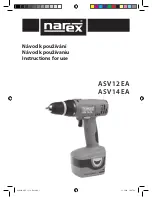
LABPS23023
V. 04 – 18/08/2016
5
©Velleman nv
The C.C.-control switches [4] and [20] are generally placed in the max. position when the adjustable
outputs are used as C.V.-outputs. With this particular device, however, the current-limiting point can be set
by the user. Use the following procedure: Switch on the device and place the C.C.-control switches [4] and
[20] in the min. position. Short the positive and negative output terminals. Consequently, the user should
adjust the position of the C.C.-control switches [4] and [20] until the output current matches the required
current-limiting point.
6.2
Connecting the two adjustable outputs in series
Place switch [11] in the ON-position and leave switch [12] in the OFF-position. When the user adjusts the
output voltage of the master [21], the slave output will automatically follow suit. The max. output voltage
is 60V [voltage between the terminals of [8] and [15]].
Examine whether the negative terminals of both the master and slave output are connected to the "GND"-
terminal [ground]. If so, the user should disconnect them in order to avoid a short-circuit when the two
outputs are connected in series.
When the two outputs are connected in series, the output voltage is controlled by the master output. The
current adjustments of the two outputs, however, are still independent of each other. This is why the user
should check the position of the C.C.-control switch [4]. The voltage of the slave output will not be identical
to the voltage of the master if, for example, the C.C.-control switch [4] is in the min. position or if the
current of the slave output exceeds the current-limiting point. Consequently, the C.C.-control switch [4]
should be placed in the max. position when the two adjustable outputs are connected in series.
Use appropriate test leads to short the negative terminal of the master output with the positive binding post
of the slave output if the two adjustable outputs are connected in series. Failure to do this will cause the
current to run through the shorted switch, as the negative terminal of the master output is shorted by
switch [11]. This will affect the reliability of the device.
6.3
Parallel use of the two adjustable outputs
Put both switch [11] and [12] in the ON-position. The two adjustable outputs are now connected in parallel.
Use control switch [21] to adjust the C.V. of the master output. The voltage of master and slave will remain
identical to each other and the C.C.-indicator [6] of the slave output will light.
The C.C.-control switch [4] of the slave output does not work when the two adjustable outputs are
connected in parallel. Subsequently, the operator should use the C.C.-switch [20] of the master output
when one of the adjustable outputs is used as constant current supply. The output current of the master
and slave outputs are identical to each other and both are now controlled by [20].
Use test leads to connect the two positive and negative terminals of the master and slave outputs when the
two adjustable outputs are connected in parallel. This is necessary to ensure a reliable connection between
the load and the two outputs connected in parallel. The current of the two outputs may not be identical if
the load is connected to only one output terminal. This may cause damage to series/parallel switches [11]
and [12].
The digital display carries 3 digits. Use a more precise measuring instrument to calibrate the load if you
need a more accurate indication.
Note
The 5V-output has optimal protection thanks to the short-circuit protection and the current-limiting point, a
feature also present in the two adjustable outputs. The power loss in case of short circuit is limited thanks to
the protection circuit that controls the power loss of the transistors in the power supply. This feature keeps the
device from being damaged. Nevertheless, the short circuit should be repaired as soon as possible in order to
prevent wear and unnecessary power consumption.
7.
Cleaning and Maintenance
Disconnect the device from the mains prior to maintenance activities.
The power supply cables must not show any damage. Have a qualified technician maintain the device.
Wipe the device regularly with a moist, lint-free cloth. Do not use alcohol or solvents.
There are no user-serviceable parts, apart from the fuse. Contact your dealer for spare parts if necessary.
Store the device in a dry, well-ventilated, dust-free room and keep it clean. Remove the power plug if the
device is to be stored for a prolonged period of time.






































